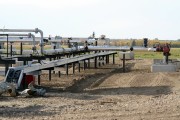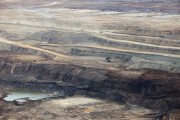This week, the federal government passes regulatory power over lands and resources in the Northwest Territories (NWT) to the Government of the Northwest Territories (GNWT). Yet, despite the fanfare, the promise of Northern control over lands and resources is ringing increasingly hollow.
The recently passed Northwest Territories Devolution Act (Bill C-15) has two parts. The first passes jurisdiction over Crown lands and resources from the federal to the territorial government. The second contains significant amendments to the Mackenzie Valley Resource Management Act (MVRMA) — taking power away from First Nation communities and regional Aboriginal governments to give it to the federal Cabinet.
We see no good reason why these two very different parts of the Bill had to be grouped together, or why the historic step of devolution is seemingly conditional on these regulatory changes. It is as if the Bill is giving power with one hand, while taking it away with the other.
The MVRMA changes include eliminating the regional co-management boards that issue land use permits and water licenses — boards which have been doing valued work for as long as 14 years. Instead, the Bill consolidates permitting and licensing into one board based in Yellowknife with much smaller proportionate representation from each of the Aboriginal governments. Until this week, appointed members selected chairs. Now, the Bill gives a federal Minister the power to appoint the Chair of the consolidated board. The federal minister also gains the power to give binding policy direction to the remaining co-management boards that conduct land use planning and environmental assessments.
The regulatory system laid out in the MVRMA was established based on Comprehensive Land Claim Agreements that were negotiated over decades with Gwich’in, Sahtu, and Tłı̨chǫ elders and leaders. Now, the Aboriginal governments feel these agreements have been dishonoured. The Tłı̨chǫ have launched a lawsuit against the federal government on this basis.
Each time federal government representatives came from Ottawa to consult with Northerners about these changes, they heard strong, vocal, and consistent opposition by Aboriginal governments and communities, existing regulatory boards, and advocates for the public interest. Unfortunately, the final federal bill seems to have ignored these concerns. The GNWT initially took a position opposing the changes, but later accepted them as a price it would pay for devolution.
Meanwhile, the GNWT has been crafting its own new regulatory structures behind closed doors. Up until now, the National Energy Board has been regulating oil and gas activities in the NWT. Exactly one month before devolution came into force, the GNWT announced that the NWT’s new oil and gas regulator would be David Ramsay, the territory’s Minister of Industry, Tourism and Investment. It was also announced that the Minister would be contracting out technical and advisory services for new onshore oil and gas applications to the Alberta Energy Regulator (AER), since the GNWT does not currently have staff with adequate expertise. The terms of this contract with the AER have not been made public.
Many Northerners have concerns about this set-up, particularly given Alberta’s reputation for facilitating rapid oil and gas expansion and the AER’s lack of experience dealing with northern communities and globally significant ecosystems in the North. While the GNWT’s Minister of Industry praises the AER, and the federal government’s website declares that the unique NWT regulatory structure is too “complex” for industry, northerners remain proud of their made-in-the-north regional co-management boards and hard-won comprehensive land claims.
Alberta’s failure to appropriately manage the cumulative impacts of its own energy development should act as a cautionary tale for the NWT. Like his Alberta and federal counterparts, however, Minister Ramsay seems to be overwhelmingly focused on “getting our resources to market” and moving forward with many industrial projects as quickly as possible.
The NWT’s co-management boards are currently understaffed and underfunded to handle an increasing number of large-scale industrial applications. In order to maintain high-quality screenings and environmental assessments, the boards largely rely on expert input from scientists in federal and territorial agencies such as Environment Canada, the Department of Fisheries and Oceans (DFO), and GNWT Environment and Natural Resources. Input from these bodies has already been hampered by cuts to Environment Canada and to DFO.
In early March, GNWT Ministers revealed that, beginning April 1st, all federal comments on industry applications would be funnelled through the Canadian Northern Economic Development Agency (CanNor) — the agency responsible for promoting industrial activity in the North. Meanwhile all territorial government comments will be coordinated through the new GNWT Lands Department, which will contain a mixed mandate of land protection and industry promotion. That mixed mandate creates the risk that scientific considerations could be diluted by efforts to facilitate industrial development. Co-management boards could receive little evidence on which to base their decisions, and much of the discussion about potential impacts from industrial projects, and possible mitigation measures, will be carried out in private at the internal territorial and federal levels, with little public attention
The regulatory system in the NWT has taken decades to build. Notably, it had included First Nation community voices, which are in danger of once again being muted. By passing these two Acts within the same Bill, the federal government has countered the benefits of devolution with a significant weakening of the NWT regulatory system. Most of the changes have been forced through despite either strong public opposition or little to no public input. While devolution has some Northern leaders triumphant, proclaiming Northern control over lands and resources, the evidence suggests most Northerners—including Aboriginal governments—will now have even less say over what happens to our land and water.







